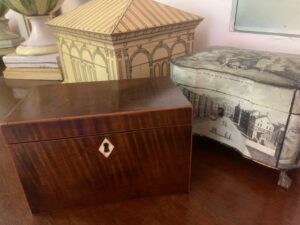 My southern grandmother, Ruth Sophia, and her family loved tea. Aunt Kathleen and the elder Aunt Sylvia drank tea all day long in old Saint Louis. I inherited that love, and carried on a love affair with tea in England for three years, after which I married a Scot. I still drink my tea with milk, and own a collection of British tea caddies, and brass and bronze tea scoops.
My southern grandmother, Ruth Sophia, and her family loved tea. Aunt Kathleen and the elder Aunt Sylvia drank tea all day long in old Saint Louis. I inherited that love, and carried on a love affair with tea in England for three years, after which I married a Scot. I still drink my tea with milk, and own a collection of British tea caddies, and brass and bronze tea scoops.
Scholars speculate that the history of Britain in the 18th and 19th centuries heavily depended on tea. Plus the shadier side of the tea trade, the opiate trade. Not to mention all the colonial interests and taxes involved.
The Value of Tea
The great expense of tea in the early 18th century influenced the SHAPE of the tea caddie. They usually came with handles so the owner of the tea leaves took them with her. The interior compartments appear smaller than your fist. Made of pricey veneers and marquetry, and sometimes edged in ivory and sterling, most caddies were lockable. Consumers considered tea precious, until the mid-18th century, when the black market began to smuggle it over from China.
Holland and Portugal knew about tea fifty years before the court of Charles II discovered it. His Portuguese wife brought it to England in the late 17th century. This gave birth to the tradition of the pause in the day religiously followed to brew tea and to drink it with LOADS of sugar.
Men of the world drank hugely expensive cups of it in coffee shops. Ladies bought leaves in small apothecaries.
What Does Caddie Mean?
The bound between the tea trade and the opium trade led to the name CADDIE, a reference to the Malaysian word for three-fifths of a kilo–“Kati.” Exporters packed tea in glass bottles and metal jar in this kati size, and shipped them in straw. Then cabinetmakers in Britain created mahogany boxes with one, two, or three compartments to house the glass or metal containers.
Soon they made showy boxes with separate compartments as part of the tea ceremony. Simpler folk owned tea caddies with two compartments, one for tea, one for sugar, lined with a tin lead alloy called “tea pewter,” unless they stored their own containers inside. Wealthier families owned triple caddies, with the center having a tea bowl for mixing the different leaves on either side in a custom blend. If unblended, they used the glass jar for sugar.
Politics and the Price of Tea
Political unrest over the price of tea continued to dog the politics of Britain, until the first half of the 19th century. England became wealthier in general and more populated. The middleclass rose, and the world of fine design became of interest to all Britons because of the architectural styles of The Prince Regent. He died in 1830, but his influence was felt throughout the century.
Medical improvements contributed to the increase of the population of the country to eighteen million, double fifty years previously. Trade became an opportunity to all, not just the aristocracy. Class structures polarized even as the middleclass grew stronger. With that everyman wanted to drink tea like the upper classes.
In 1833 Britain withdrew the monopoly of the East India Company to import tea, reducing prices, and forming new trade partners for tea with the merchants of India in 1839. Indian tea cost less than China tea, and the middleclass craved those little tea caddies. They hired carpenters to design them in plain wood, accented with gorgeous veneers, for which process a machine was invented in the 1820s.
By the 1840s England added New Zealand to the list of countries exporting lumber along with the Far East, the Islands, Africa, and the Americas. Because the veneers of the day were thicker than the veneers we NOW use, the edges of the cadies were “waterproofed” with a band of metal or herringbone inlay. Reasonable priced veneered tea caddies with a decorative surface emerged. Today they’re ubiquitous in the antique market.
I put the value of the box at $100, definitely a middleclass 19th century version.
Pingback: Melmac: A Story of Modernity - Elizabeth Appraisals